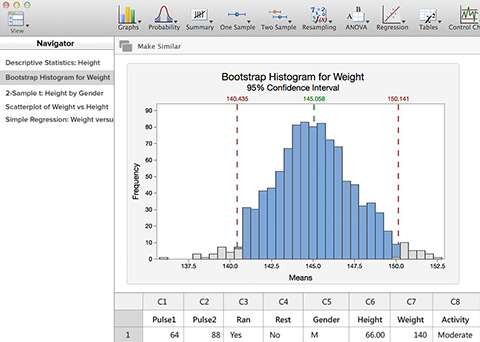

It is probably also a good introduction to high-level programming for Operations Research students.

I can see that R is brilliant for second-level and up in statistics, preferably for students who have already mastered similar packages/languages like MatLab or Maple. It is extremely versatile, and pretty daunting for an arts or business major. R is what you expect from a command-line open-source program. SPSS shows its origins as a suite of barely related packages, in the way it does things differently between different areas. It has a much larger suite of analysis tools, including factor analysis, discriminant analysis, clustering and multi-dimensional scaling, which I taught to second year business students and research students. I really like the data-handling in terms of excluding data, transforming variables and dealing with missing values. It’s a useful package, with its own peculiarities. Much of the analysis for my PhD research was done on SPSS. Most of my teaching at second year undergraduate and MBA and Masters of Education level has been with SPSS. The main reason for this is that the students are unlikely ever to have access to Minitab again, and there is a lot of extra learning required in order to make it run. It has been some years since I taught with Minitab. Its roots as a teaching package are obvious from the user-friendly presentation of results. Minitab is a lovely little package, and has very nice output. One day Helen and I will make a video about PivotTables. I made my students create comparative bar charts on Excel, using Pivot-Tables. They may well be one of the most useful things I have ever taught at university. I resisted teaching PivotTables for some years, but I was wrong. PivotTables in Excel are nasty to get your head around, but once you do, they are fantastic. Excel is the best package for first year business students for so many reasons. These reasons may not apply to all students. So, given these shortcomings, why would you use Excel? Because it is there, because you are helping students gain other skills in spreadsheeting at the same time, because it is less daunting to use a familiar interface. Each time Excel upgrades I look for this small fix, and have repeatedly been disappointed. It requires elementary Visual Basic to correct this, but has never happened. For example when you click on a radio button to say where you wish the output to go, the entry box for the data is activated, rather than the one for the output. There are programming quirks which should have been eliminated many years ago. The output is idiosyncratic, and not at all intuitive. The data-handling capabilities of the spreadsheet are fantastic, but the toolpak cannot even deal well with missing values. There is no straight-forward way to do a hypothesis test for a mean. I am told there are parts of the analysis toolpak which are wrong, though I’ve never found them myself. There are many problems with statistical analysis with Excel. I have already written somewhat about the good and bad aspects of Excel, and the evils of Excel histograms. Here are my pros and cons for each of these, and when are they most suitable. I have dabbled in R, but never had students who are suitable to be taught using R. These days I am preparing materials for courses using iNZight, which is a specifically designed user interface with an R engine. Over the years I have taught statistics using Excel, Minitab and SPSS. If they are research students and need to take the course as part of a research methods paper, then they should be taught on the package they are most likely to use in their research. If the students are strong in programming, such as engineering or computer science students, then they are less likely to find the programming a barrier, and will want to explore the versatility of the package. If the students are never likely to do any more statistics, what matters most is that they understand the elementary ideas, feel happy about what they have done, and recognise the power of statistical analysis, so they can later employ a statistician. What is it that you want them to feel and do and understand? You have to ask yourself, what are the attitudes, skills and knowledge that you wish the students to gain in the course. The short answer is: It depends on your class.
#What is minitab update#
Update in April 2018: I have written a further post, covering other aspects and other packages. I often hear this question: Should I use Excel to teach my class? Or should I use R? Which package is the best?


 0 kommentar(er)
0 kommentar(er)
